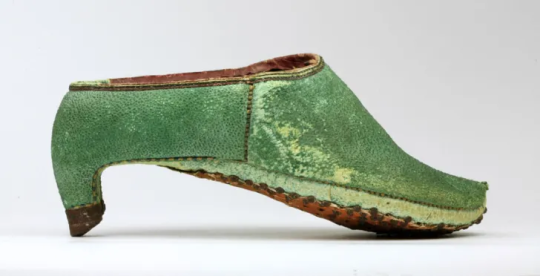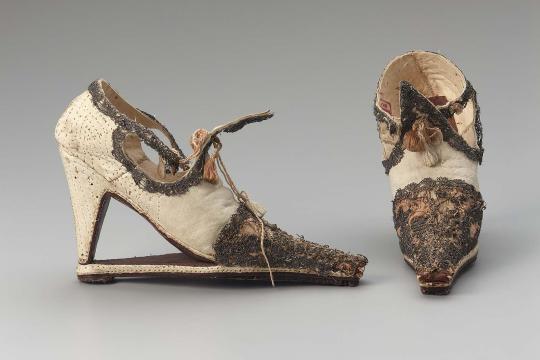#i really dont care
Content warning: Discussion of grievous bodily injury
So, both my first two theories on the origin of high-heeled shoes in European fashion turned out to be bunk. I mean, I know that originally men wore high heels, but I did not expect the manner in which they appeared on the fashion scene.
(And no, the answer isn’t “butchers” either. Butchers in ancient Egypt wore high heels. Then they went out of fashion for, uh… a while.)
(And yes, I already said that high heels weren’t integral to my line of research. I spent a day writing up this post anyway. NOT EVEN I CAN STOP MYSELF SOMETIMES.)
My first theory was kind of wild. I thought high heels might be descended from the wooden platform shoes medieval Europeans wore to keep out of muddy conditions:

It would have been cool because platform shoes got RIDICULOUS, but we’ll have to get back to chopines another day. They don’t feature in this story.
As I got deeper into the research, I had to admit to myself that I was subconsciously expecting high heels to evolve from what I thought of as “conservative” and “natural” heels, to the more “refined” and “unnatural” heels.

But that’s projecting modern sensibilities into the past. These days we’re concerned with whether shoes will fit with our lives, the ways we move and the spaces we live with. We don’t even know what the concerns of the past are, and therefore aren’t good at predicting why they’d pick one shoe over another.
I therefore did not expect the shoe that convinced sixteenth-century Europe that high heels were the Next Big Thing to be… this one.

Not that exact pair, you understand, so it’s not just because of that absolutely divine aquamarine colour. But those are one of the best extant examples of 16th century Persian cavalry shoes.
In fact, those are
elite tactical military gear
I’ll explain, but it’s gonna get dark.
Let’s talk horses

(HORSE PEOPLE: DON’T GET UP MY GRILL ABOUT INCONSEQUENTIAL DETAILS, PLZTHX)
Horses are big round sleek bundles of nerves. They’re prey animals. They like to jump and start and flee from anything they find dangerous. Their nerves and smooth round sides make them amazingly easy to fall off of, if you don’t have a saddle. Generally people doing complicated or quick maneuvers bareback ride with one hand on the reins to guide them, and one hand gripping the horse’s mane tightly for balance.
As you might know, humans only have two hands. This setup leaves no hands free for anything like weapons; if you want to do anything else, you have to sacrifice either steering or stability. Before the stirrup was invented, horses were mostly used in warfare to pull chariots, or as moving platforms from which warriors could throw themselves before joining the fight.
But cast your eyes back to that horse up above. That horse has stirrups. The stirrup is the little square hanging below its tummy, hanging by a line to the saddle. The saddle is held stable by a strap around the horse’s midsection, so by putting their feet into stirrups on either side, the rider is able to stay much more balanced and steady. And now? They can ride with one hand free. They can even have both hands free for short periods of time. They can hold weapons and get close to their enemies.
Over the last century horses have almost completely disappeared from military and civilian life, except as quaint curiosities. It’s easy to lose sight of how absolutely pivotal they were to warfare, for millennia. The thing that’s replaced them, the modern “cavalry”, are tanks and helicopters. And the core mythos of European aristocracy is that they’re the descendants of old and mighty mounted warriors. Cavaliers. Chevaliers. Caballeros.
(Cowboys are misnamed. They oughta be horseboys.)
And stirrups have a fatal flaw. (CN: Grievous injury. Horse people, you know what’s coming; take a deep breath.)

If you fall off your horse, your horse will probably be startled (if it wasn’t already startled before you fell off) and want to run away from the thing that startled them (you).
If you fall off your horse and your foot stays in the stirrup,the horse will want to run away from you–so it will drag you after it.
If you are fortunate, you will stay to the side of your horse’s back legs, and your foot will come free or your horse will be stopped quickly. If you are not fortunate–let’s say, the stirrup is around your ankle, so your foot and heel are essentially anchoring you in place–your torso or head will end up under the very solid hooves of a thousand-pound animal as it panics and tries to escape you, and it is quite possible that you will be dead before your horse gets tired of running.
Being “caught up” or “hung up” in a stirrup doesn’talwaysresult in death, spinal injury, broken bones, or other grievous bodily harm, especially when riders wear head and torso protection. But… I found an illustration of the phenomenon because it’s a picture of a person who died 700 years ago, not 30 or 20 or 10.
Also because looking at photographs of people caught up in stirrups makes my gut churn, because I used to bea horseperson so I’ve seen that shit live. Watching it happen feels shitty and helpless, and if you’re not already on the ground near the horse and able to catch it, there’s almost nothing you can do.
And so, therefore, you are now equipped to understand just how valuable it would be to have a shoe that stopped your foot from getting stuck in your stirrups, even if it forces you to walk funny when you dismount.

This 15th century Persian picture demonstrates just what’s going on: The stirrup rests on the forward part of the foot, and the heel prevents it from sliding any further back. That fatal anchoring is way less likely to happen.
Now that we’re all appropriately somber and appreciative of this shoe’s full context, I feel that we’re ready to behold what seems to be that same aquamarine shoe (or its mate) as a boot, which you could walk down any Parisian runway today in and look completely avant-garde.

Isn’t it glorious?
The military stiletto was not a long-lived fad, either in Europe or Asia. I would wildly conjecture that this had to do with the increasing use of cannons and firearms on the battlefield. They could punch through the heaviest armour from a long way away, and people sitting on horses are very visible targets, so cavalry soldiers had to focus on their ability to fight on foot if unhorsed. This is also why the period of 1500-1600 saw knights dump a great deal of their heavy plate armour.
(It’s not that you can’t fight on foot in full plate armour, it’s just… there’s a cost/benefit thing going on between weight and protection and stamina and speed, especially if you have to, say, not be the slowest man at the back of a pack of lightly armored infantry running for your lives from an enemy with a rifle, you get me?)
Civilians, meanwhile, got hold of the high heel and never looked back.
Italy, and especially Venice, was Europe’s first point of contact for most things coming from Asia or North Africa, and what records we have say that Venice is where Europeans got on trend, in the 1580s. Venetians fell for high heels with absolute glee.
Context: Back before freedom of religion was a thing, The Catholic Church and the governments in its sphere waged a never-ending legislative battle against the sins of, uh… I’m not up on my catechism, but basically, People Thinking They Look Good, People Having Nice Things, People Getting Ideas Above Their Station, and People Being Horny. In previous centuries the battle had primarily focused on things like Absolutely Gigantic Sleeves, but in the 1500s the real hot zone in Italy became Astronomically Tall and Gorgeous Shoes, which is the subject for a future post.
So the high heel was the perfect end-run around those laws. The ball of the foot stayed close to the ground, so it wasn’t really an illegally nice shoe! It still gave that extra something, but it was easier to walk and dance in, and it made men’s calves look super nice. And anyway, with this version, there’s some kind of reasonable human limit to the height of the heels, where previous Tall Gorgeous Shoes sometimes approached the proportions of low stilts.

We get these “slap-sole” shoes because the biggest civilian concern was the high heel’s tendency to sink into mud, so they made flat platforms for the sole to rest on. The toe would be fixed in place with the heel left free, so the foot can move more normally through the gait cycle. This means the heel would lift up a bit in the air, and then hit the platform during touchdown; apparently the clacking noise it made was distinctive and carried a cachet of elegant luxury.
I honestly don’t know why Louis XIV decided that chunky heels were the way to go. My only working theory is maybe… they made better ballet shoes? I’m not joking; the man was an avid ballet dancer, and danced at every opportunity he got. Maybe chunky heels are less likely to wear out, break, or come apart than smaller ones. But that’s still only a theory.
In conclusion: God, humans are so fucking weird. I love us.

Further Reading:
Bata Shoe Museum - Standing TALL: The Curious History of Men in Heels
Bata Shoe Museum - The Height of Fashion: Conservation of a Pair of 17th Century Slap Sole Shoes
Shoes: A History from Sandals to Sneakers, edited by Giorgio Riello and Peter McNeil. Book; 2006. It’s massively huge and heavy and also full of scholarly research and not just a glorified Pinterest board, which is more than I can say for everything else I checked out of the library.
TYPGRPY#1
You had your chance but you let go! - Demi Lovato (I Really Dont Care)
[gabriel gutierrez design 2015]
More Artworks Here:
https://www.behance.net/gabrielcreates
https://instagram.com/pgabogutierrez/
http://gabrielcreates.tumblr.com/
https://www.facebook.com/itstheggutierrez
Post link



